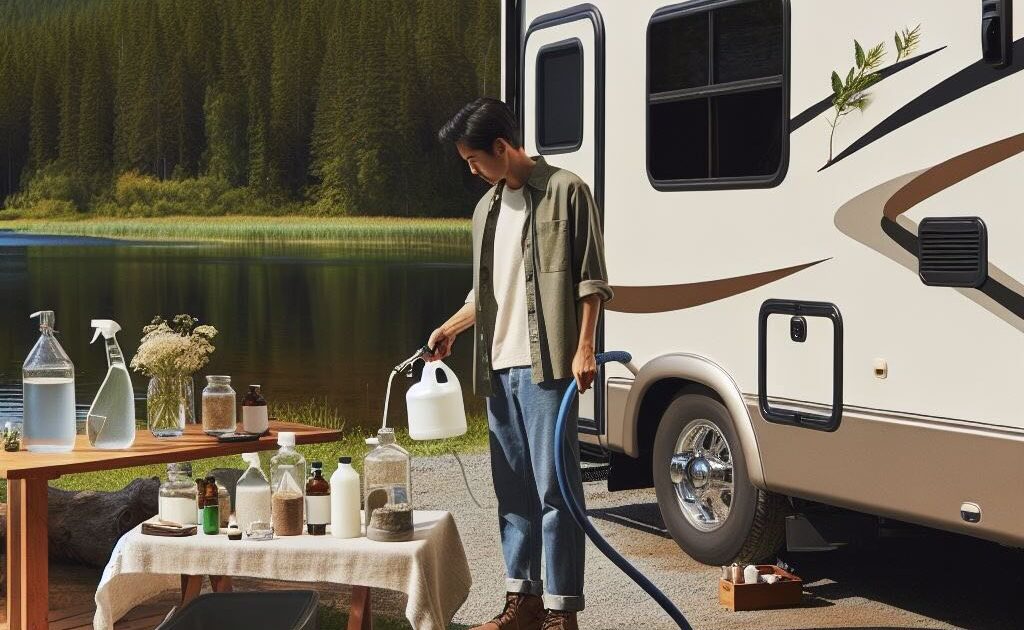Our instructions:
1. Drain the Fresh Water Tank
Start by draining your fresh water tank completely. Open the drain valve and let all the water flow out to ensure no stagnant water remains. Make sure to drain both the tank and all water lines inside your RV.
2. Choose Your Natural Sanitizer
Vinegar and hydrogen peroxide are two of the best natural alternatives to bleach. Both are effective at killing bacteria and are safe for your RV’s water system.
- White Vinegar:
Use a ratio of 1 gallon of vinegar for every 10 gallons of water in your tank. Vinegar is mildly acidic and can clean and deodorize the water tank.
- Hydrogen Peroxide (Food-Grade):
Use 1 cup of hydrogen peroxide (3%) per 10 gallons of water. Hydrogen peroxide is a powerful disinfectant and breaks down into water and oxygen, leaving no harmful residue.
You can also add a baking soda rinse after sanitizing with vinegar to neutralize any lingering odors.
3. Add the Vinegar or Hydrogen Peroxide to the Tank
Use a funnel to pour the vinegar or hydrogen peroxide into your fresh water tank. After adding your chosen sanitizer, fill the rest of the tank with clean water to dilute the solution and ensure it can fully circulate through the system.
4. Run the Solution Through the Water Lines
Turn on your RV’s water pump and open all faucets, including hot and cold taps, showers, and outdoor spigots. Let the vinegar or peroxide solution run through until you smell it coming from each faucet. This ensures the solution reaches all areas of your plumbing system.
5. Let the Solution Sit
Allow the solution to sit in the tank and water lines for at least 4 to 12 hours. This gives it enough time to disinfect the entire system thoroughly.
6. Drain the Tank and Flush with Fresh Water
After the sanitizing solution has sat for the necessary time, drain the tank and water lines again. Refill the fresh water tank with clean water and run it through all faucets to flush out any remaining vinegar or peroxide. Repeat this process until the smell and taste of the solution are completely gone.
7. Optional Baking Soda Rinse
If you’ve used vinegar and still notice a lingering vinegar smell, you can do a baking soda rinse to neutralize the odor. Add 1/2 cup of baking soda per gallon of water, run it through the lines, and let it sit for a few hours before draining and flushing with clean water.
Why Use Vinegar or Hydrogen Peroxide?
- Natural & Safe: Both vinegar and hydrogen peroxide are natural disinfectants that break down harmlessly, making them safe for your health and your RV’s water system.
- No Chemical Taste: Unlike bleach, these alternatives leave little to no taste or odor behind once thoroughly flushed from the system.
- Non-Toxic: Vinegar and hydrogen peroxide are non-toxic options, making them ideal if you’re concerned about chemicals in your drinking water.
Maintenance Tips for a Clean Fresh Water Tank:
- Sanitize Regularly: Even with natural methods, it’s essential to sanitize your fresh water tank at least twice a year or before long periods of storage.
- Use a Water Filter: Consider using a water filter when filling your fresh water tank to reduce the chances of contaminants entering your system.
- Keep the Tank Dry When Not in Use: Draining the fresh water tank when your RV is in storage or not in use prevents bacteria and mold from growing in standing water.
At Custom-way, we recommend regular maintenance for your RV’s water system to ensure you always have access to clean, fresh water. Whether you prefer natural methods or more traditional sanitizing solutions, keeping your water system clean is key to enjoying your RV adventures without worry.

